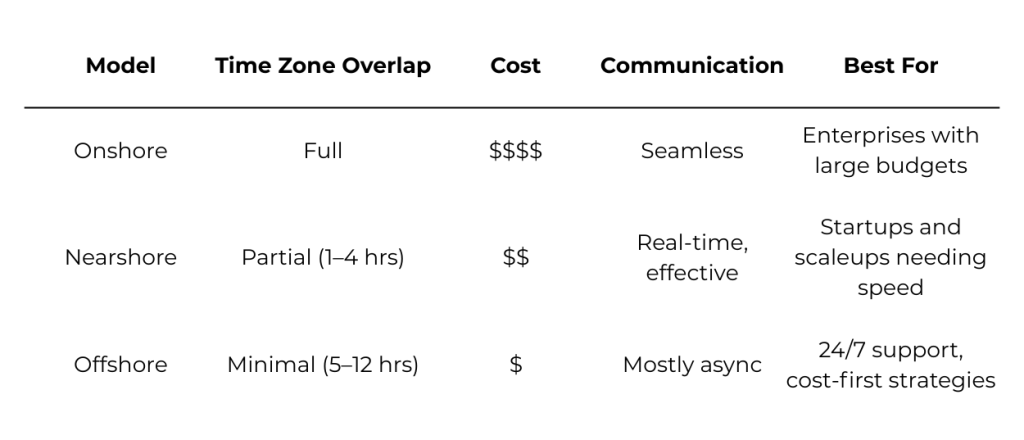Intro
In 2025, the world’s most competitive tech companies aren’t asking if they should outsource software development — they’re asking where to do it best.
With product demands growing, AI reshaping every industry, and teams under constant pressure to move faster without overspending, nearshore outsourcing has become a go-to strategy. That’s why more CTOs, startup founders, and product leaders are turning to nearshore partners — to accelerate roadmaps, scale engineering teams with precision, and maintain full control over quality and timelines.
Table of Contents:
Nearshore software development means partnering with teams in nearby countries, usually in the same or similar time zones. This gives you the ability to collaborate in real time, scale faster, and cut costs — all without compromising code quality, communication, or control.
It’s the outsourcing model built for modern, agile product development:
- Real-time collaboration (no 12-hour async delays)
- Culturally aligned, highly skilled talent
- 30–70% lower cost than hiring locally
- Legal and IP protections aligned with global standards (GDPR, CCPA)
Whether you’re launching an MVP, augmenting your dev team, or replacing an underperforming offshore vendor, nearshore software development is now the smartest way to build fast, stay lean, and maintain full control.
This definitive guide will walk you through everything you need to know to build winning nearshore partnerships — and outperform your competition:
- What nearshore software development really means in 2025
- The top regions, vendors, and ecosystems shaping the market
- How to choose the right partner (with checklists, questions, and red flags)
- Emerging trends and proven success metrics to scale faster and smarter
Let’s start with the basics — so we’re clear on what nearshore outsourcing really is, and why it’s becoming the default choice for world-class software teams.
What Is Nearshore Software Development?

Nearshore software development is a form of outsourcing where you partner with engineering teams in nearby countries — typically within a 1–4 hour time zone difference. It offers a strategic balance between hiring locally (onshore) and outsourcing to distant regions (offshore).
In short: you get real-time collaboration, cost savings, and cultural alignment, without the communication delays or quality trade-offs of offshore setups.
Why Nearshore Development Delivers Maximum Value
Compared to other outsourcing models, nearshoring offers the best of all worlds:
- Real-time collaboration during your work hours
- Seamless communication thanks to shared language and workflows
- Significant cost savings over local hiring
- Easier cultural and operational alignment

Nearshore Outsourcing, Defined
Nearshore outsourcing refers to partnering with remote software teams located in neighboring or nearby countries. Unlike offshore models that often involve significant time zone gaps and cultural barriers, nearshore teams operate in similar working hours, enabling real-time collaboration. They typically speak the same language (or close to it), easing communication and reducing friction. Nearshoring also offers significant cost advantages — often 30–70% lower than hiring locally — while maintaining control over quality, timelines, and intellectual property protections.
Real-World Nearshore Pairings
- EU / UK companies → Romania, Poland, Ukraine
- US startups → Mexico, Colombia, Argentina
- Singapore-based firms → Vietnam, Malaysia, the Philippines
These teams work your hours, speak fluent English, and align with Western workflows — making integration with your in-house teams frictionless.
Nearshore vs Offshore vs Onshore

Want to see how this model works in action?
Explore how our Nearshore Development Centre approach ensures same-zone work dynamics, real-time collaboration, and elite engineering support for agile product teams.
Why Nearshore Software Development Makes Sense in 2025
As software cycles accelerate and teams become more distributed, nearshore development is becoming the preferred solution for tech-forward companies.
Here’s why:
- Real-time collaboration with developers working your hours
- Easier communication with fluent, culturally aligned teams
- Up to 70% lower development costs vs. local hiring
- Legal protection and compliance (GDPR, CCPA, NDAs)
- Fast integration into agile sprints, roadmaps, and CI/CD pipelines
Not Just Cheaper. Smarter.
Nearshore isn’t just a way to save money. It’s a faster, more flexible, and more strategic way to build.
It gives you:
- The speed and flexibility of in-house development
- The reach of a global talent network
- The cost-effectiveness of offshore — without the timezone and quality headaches
In 2025, nearshoring isn’t a trend, it’s the new standard for high-performance software teams.
Why Nearshore Outsourcing Is Booming
The demand for nearshore software development has surged over the past 3 years — and that’s no accident. It’s a direct response to what modern tech companies need most: speed, talent, savings, and control.
The Numbers Behind the Boom:
- 64% of all global outsourcing is now software-related
- Nearshore demand is growing fastest in Western Europe and North America
- 75%+ of EU tech companies are actively exploring Eastern Europe as a strategic nearshore destination
- 80%+ of US tech companies are now exploring Latin America for nearshore hires
- Companies report up to 28% faster time-to-market and 41% lower burn rate when nearshoring
What’s Driving the Surge?
Time-Zone Overlap = Real-Time Velocity – Unlike offshore models, nearshore teams work during your hours — leading to tighter feedback loops, faster problem-solving, and fewer blockers.
Cost-Effective Scale – Most nearshore rates are 30–70% lower than domestic salaries, without sacrificing communication or output quality.
Access to Top Talent – Regions like Romania, Colombia, and Poland are producing exceptional engineers, supported by strong STEM education, high English proficiency, and remote-first national strategies.
Legal and Compliance Alignment – Countries aligned with GDPR, CCPA, and other global data standards offer safer, smoother engagements.
Built for Agile Product Teams – Nearshore partners often support fractional hires, dedicated teams, and hybrid models — ideal for dynamic startup and scaleup environments. Explore how agile and nearshore outsourcing align to support rapid iteration and delivery.
Top Nearshore Regions in 2025 (And How to Choose the Right One)
Choosing the right nearshore region isn’t just about geography, it’s about matching your business goals, budget, time zone, compliance needs, and collaboration style with the right engineering ecosystem.
In 2025, three regions lead the nearshore outsourcing landscape: Eastern Europe, Latin America, and (for APAC-based firms) Southeast Asia. Each has unique strengths — but only one may be the optimal fit for your product roadmap and team structure.
Let’s break them down.
Eastern Europe – Ideal for UK and EU-Based Teams
Top Countries: Romania, Poland, Ukraine, Bulgaria
Why it works:
- Minimal time difference for UK and EU clients (0–2 hours)
- Highly educated engineers, many with EU-recognized certifications
- Strong English proficiency and familiarity with Western workflows
- Full compliance with GDPR, IP protection, and enterprise-grade security
Hotspot Highlight:
Romania continues to stand out for its high concentration of senior developers, multilingual engineers, and long-term team stability — making it a smart choice for regulated industries and scalable product builds.
Use nearshore in Eastern Europe if:
- You’re based in EU or the UK
- You need strong governance, enterprise security, or data compliance
- Quality and engineering maturity are top priorities
Latin America – Best for US and Canadian Companies
Top Countries: Colombia, Mexico, Argentina, Costa Rica
Why it works:
- Full or near-full time zone overlap with US and Canadian teams
- A growing pool of English-speaking, STEM-educated developers
- Strong cultural alignment with US business practices
- Mature tech hubs in fintech, SaaS, mobile development, AI and DevOps
Hotspot Highlight:
Medellín, Colombia continues to rise as a leading Latin American tech hub — often called “The Silicon Valley of South America.” Government-backed initiatives, tax incentives, and startup accelerators have made it a magnet for talent.
Use nearshore in Latin America if:
- You need daily, real-time collaboration with minimal timezone friction
- Your product team works in fast-paced agile sprints or lean product cycles
- You want competitive rates without sacrificing communication or quality
Southeast Asia – Best for APAC-Based Companies (Not US/EU)
Top Countries: Vietnam, the Philippines, Malaysia
Why it works:
- Partial time zone overlap with Singapore, Australia, and East Asia
- Excellent price-to-performance ratio, especially for QA, backend, and mobile
- Rapidly improving English fluency and engineering culture in major cities
Hotspot Highlight:
Ho Chi Minh City and Manila are emerging as serious tech hubs in Southeast Asia, with growing investments in engineering education, AI capabilities, and startup ecosystems — especially attractive for APAC-based companies needing fast, affordable delivery.
Use Southeast Asia if:
- You’re headquartered in APAC
- You want to scale cost-effectively with hybrid or async collaboration
- Your need access to well-priced, full-stack teams with growing DevOps and mobile expertise
How to Choose the Right Nearshore Software Development Region
- Time zone compatibility: Do you need real-time collaboration or can your team operate effectively with asynchronous workflows?
- Talent specialization: Are you building a mobile app, SaaS product, AI feature set, or enterprise platform?
- Compliance & culture: Do you require GDPR compliance, enterprise security, or deeper integration?
Top Nearshore Software Development Companies in 2025
In a global economy driven by digital products and accelerated by AI, finding the right development partner is no longer optional — it’s your next competitive edge.
But in a crowded vendor landscape, how do you separate buzzwords from real capability?
This 2025 shortlist cuts through the noise.
We’ve analyzed contenders across Eastern Europe, Latin America, and Southeast Asia to bring you a curated lineup of the best nearshore software development companies in the world — ranked by delivery consistency, technical maturity, client satisfaction, and cultural alignment.
These aren’t just staffing agencies or code factories. They’re long-term engineering partners — capable of embedding into your product lifecycle, owning delivery KPIs, and accelerating your roadmap without the time zone or quality compromises that often affect offshore engagements.
Each company listed below was vetted using a rigorous criteria stack:
- Proven client success across SaaS, fintech, healthcare, and enterprise
- Strong presence in nearshore-friendly time zones (EU, UK, US)
- Fluent English communication and agile delivery frameworks
- Engineering excellence, with emphasis on backend, DevOps, and cloud-native architectures
- Verified security posture (ISO, SOC 2, GDPR compliance)
Whether you’re launching an MVP, scaling your platform, or replacing an underperforming offshore vendor, the companies below offer the real-world expertise, regional proximity, and agility modern CTOs and founders demand.
Let’s dive in.
Arnia Software – Romania
(Founded in 2006 | 500 – 1,000 employees)
Why Arnia Leads in Enterprise Nearshore
With nearly two decades of experience, Arnia Software has emerged as one of Eastern Europe’s most established development firms. Known for long-term client relationships and a sharp focus on regulated industries, Arnia delivers mission-critical systems with a high standard of quality and compliance.
Their teams act as a seamless extension of in-house engineering units, with senior developers skilled in both modern cloud stacks and legacy modernization. Operating under EU law, Arnia offers full IP protection and GDPR compliance — making it a smart, stable nearshore choice.
Key Highlights
- Specialties: Enterprise systems, custom apps, mobile/web, AI/ML, UI/UX design, cloud migration, modernization
- Tech Stack: Java, .NET, PHP, Python, C, C++, React, Angular, Kubernetes, Azure, AWS, GCP
- Industries: Finance, tech, healthcare, energy, automotive, telecom, logistics, eCommerce
- Delivery Model: Dedicated development teams, staff augmentation, managed solutions, application development and IT consulting
BairesDev – Latin America
(Founded in 2009 | 3,500+ employees)
Why BairesDev Is a Scalable Nearshore Powerhouse
BairesDev is one of the largest nearshore providers in Latin America, partnering with Fortune 500s and high-growth startups alike. Their proprietary vetting platform screens over 1 million developers yearly to hire the top 1%, ensuring elite talent at scale.
Their global presence, multilingual teams, and agile delivery make them a go-to partner for companies seeking to accelerate development without compromising speed, quality, or time zone alignment.
Key Highlights
- Specialties: End-to-end development, staff augmentation, agile squads
- Tech Stack: React, Node.js, Python, Java, Ruby, AWS, Kubernetes
- Industries: Finance, retail, logistics, media, enterprise SaaS
- Delivery Model: Agile pods, dedicated engineers, hybrid managed delivery
10Pearls – US + Latin America
(Founded in 2004 | 1,000+ employees)
Why 10Pearls Is a Top Choice for Regulated Industries
10Pearls blends digital innovation, design, engineering, and security into one full-lifecycle offering. Founded in 2004, 10Pearls has grown into a mid-size software powerhouse, with strategic delivery centers in the US and Latin America.
They are especially trusted in compliance-heavy industries such as fintech, healthcare, and cybersecurity — combining speed with DevSecOps excellence.
Key Highlights
- Specialties: UX-driven product strategy, AI/ML, DevSecOps, digital transformation
- Tech Stack: .NET, Java, Angular, React Native, AWS, GCP
- Industries: Fintech, healthcare, cybersecurity, education
- Delivery Model: Full product teams, discovery-to-deployment lifecycle
DNAMIC – Costa Rica
(Founded in 2014 | 100+ employees)
Why DNAMIC Excels in UX-Driven Development
Founded in 2014, DNAMIC operates from Costa Rica with a tight-knit team of 50–249 engineers specializing in data, AI, and user experience. They stand out for their strong alignment with US work culture and exceptional execution in data-driven domains (healthcare, life sciences).
Focused on blending design and analytics, DNAMIC delivers polished front-end and microservice architectures that are both user-friendly and powerful.
Key Highlights
- Specialties: UX-led development, responsive web apps, microservices
- Tech Stack: Node.js, React, AWS, GraphQL
- Industries: SaaS, consumer platforms, healthcare, life sciences
- Delivery Model: Small dedicated teams, design-build alignment
Azumo – Latin America
(Founded in 2016 | 200 – 500 employees)
Why Azumo Delivers Velocity for SaaS & Startups
Azumo is designed for companies that need speed, scale, and modern cloud-native development. Their nearshore teams are built around agile squads, offering startup-level responsiveness combined with the structure of a mature software house.
Their technical depth in DevOps, ML architectures, and modern front-end frameworks enables them to launch fast and iterate even faster.
Key Highlights
- Specialties: Cloud-native platforms, mobile, DevOps, AI/ML
- Tech Stack: React Native, AWS, Docker, Kubernetes
- Industries: SaaS, digital health, fintech
- Delivery Model: Agile pods, staff augmentation, blended teams
N-iX – Ukraine & Poland
(Founded in 2002 | ~2,400 employees)
Why N-iX Is a Go-To Nearshore Partner
N-iX brings over two decades of engineering excellence to the table, serving major global clients in SaaS, manufacturing, fintech, and telecom. Known for robust delivery governance and enterprise security, N-iX is fully certified across ISO, SOC 2, and GDPR frameworks.
Their deep expertise in cloud-native architectures, big data, and AI makes them ideal for scaling platforms that require performance, compliance, and global resilience.
Key Highlights
- Specialties: Cloud transformation, AI/ML, platform engineering
- Tech Stack: Java, .NET, Python, AWS, GCP, Kubernetes
- Industries: SaaS, fintech, telecom, enterprise software
- Delivery Model: Dedicated agile teams, consulting + managed delivery
ScaleFocus – Bulgaria
(Founded in 2012 | 250–1,000 employees)
Why ScaleFocus Brings Eastern European Excellence
Founded in 2012 and operating across Bulgaria, North Macedonia, and Türkiye, ScaleFocus was recently named a “Global Outsourcing 100 Rising Star” by the IAOP for 2025.
Their hybrid nearshore delivery model bridges Western business needs with accessible Eastern European engineering expertise. Clients from areas such as financial services, healthcare, energy, and e‑commerce trust ScaleFocus for scalable software, cloud, and DevOps delivery.
Key Highlights
- Specialties: Cloud/Digital transformation, data & analytics, DevOps, custom software, legacy modernization
- Tech Stack: AWS, .NET, Java, mobile/web engineering, big data, AI/ML, RPA
- Industries: Healthcare, fintech, energy, retail, logistics, manufacturing
- Delivery Model: Nearshore development centers, managed solutions, dedicated teams
How to Choose the Right Nearshore Software Development Partner
Choosing a nearshore software development partner in 2025 is about more than vetting code quality. It’s about finding a team that fits your culture, speed, security, and scalability needs — and integrates into your business as if they were your own.
Done right, a great nearshore partnership can reduce delivery time by 30–50%, lower burn rates, and improve product velocity. Done wrong? You risk tech debt, misalignment, and missed deadlines.
Here’s how the most successful CTOs, founders, and heads of engineering are doing it in 2025 — step by step.
Step 1: Clarify Your Delivery Needs
Start by defining what type of nearshore support you need. There are three dominant models in today’s market — each suitable for different levels of internal resourcing and technical leadership.
1. Staff Augmentation
The vendor supplies vetted engineers who plug into your existing team.
→ Ideal for: Tech-driven teams with strong PM/engineering leadership in-house.
2. Dedicated Teams
A full squad (PM, engineers, QA) managed jointly or independently.
→ Ideal for: Fast-scaling startups or companies that need pods to own features.
3. Managed Delivery
The vendor owns the entire software delivery lifecycle — from scope to production.
→ Ideal for: Non-technical founders or enterprise teams with fixed deliverables.
Pro Tip: Hybrid Models are also rising: many scaleups start with staff augmentation, then shift to dedicated pods or managed delivery over time.
Step 2: Evaluate Vendors with Precision
Beyond rate cards and case studies, smart evaluation means digging into how vendors work — and how well they align with your goals.
Here’s what high-performing buyers prioritize:
- Time zone overlap: Aim for 4–6 hours of shared working time
- Seniority of engineers: Mid to senior talent means faster onboarding, less oversight
- English fluency & async readiness: Smooths out daily collaboration
- Security posture: Check for GDPR, IP protection, ISO/SOC 2 compliance
- DevOps maturity: CI/CD pipelines, rollback safety, and QA automation
- Industry familiarity: Relevant domain knowledge = better product intuition
- Contract flexibility: Can you scale up/down without vendor lock-in?
Pro insight: Ask about average engineer tenure. Low churn often signals good team health and continuity.
Step 3: Ask These Questions Before You Sign
Never rely solely on pitch decks. Ask deeper questions that test the vendor’s operational maturity and transparency.
Top questions to ask your shortlist:
- “Will I meet the actual engineers before onboarding?”
- “What’s your typical time-to-productivity for new clients?”
- “How do you handle QA and technical debt management?”
- “Can I see your standard onboarding checklist?”
- “How do you handle sprint planning, delivery tracking, and retros?”
A great vendor won’t hesitate. They’ll show you the systems behind the promises.
Pro tip: Ask about how they recover from failure. The best partners are honest about past setbacks — and how they learned from them.
Step 4: Run a Real-World Pilot
Before signing long-term, launch a 2–3 week paid pilot. You’ll gain insight into how the team thinks, ships, and collaborates under real conditions.
Include in your pilot:
- Sprint kickoff with story mapping
- Access to Slack/Jira/GitHub
- QA + code review cycles
- Mid-sprint check-ins and demos
- A retro + velocity review at the end
What to evaluate:
During your pilot, pay close attention to how the team communicates and responds — are they clear, proactive, and collaborative? Evaluate their engineering clarity by reviewing naming conventions, documentation quality, and commit hygiene.
Look at how they handle blockers and bugs: do they take ownership and resolve issues quickly, or do problems linger without accountability?
Finally, assess how well they adapt to your team’s culture, pace, and processes. The best nearshore teams won’t just deliver tasks — they’ll integrate like they’ve been with you all along.
Step 5: Onboard Like a Core Team Member
Treat your nearshore team like full-time employees — not external vendors. Integration leads to higher ownership and accountability.
What to provide on Day 1:
- Product roadmap and feature goals
- System architecture diagrams
- Design systems (Figma, Storybook, etc.)
- Clear sprint rituals and delivery KPIs
- Access to documentation, credentials, and repos
Security Reminder: Use 2FA, VPN access, NDAs, and formal IP clauses to lock in compliance.
Red Flags to Watch For
Promises without process – If a vendor offers ambitious results without showing a clear delivery framework, it’s a risk.
No access to engineers – Avoid teams that push you through sales cycles but won’t let you meet the actual developers.
No pilot or inflexible team models – Rigid team structures and refusal to run a pilot usually signal lack of adaptability.
Avoiding failure discussions – Reliable partners are honest about setbacks and how they’ve grown from them.
Lack of documentation or QA standards – Weak internal processes lead to inconsistent quality and tech debt.
Trends Shaping Nearshore Software Development in 2025
Nearshore software development has moved far beyond a simple cost-cutting tactic. In 2025, it’s a strategic growth lever — evolving in lockstep with how modern companies build, ship, and scale digital products.
Here are the most important trends reshaping the nearshore outsourcing landscape this year.
1. From Cost-Cutting to Value-Creation
Nearshoring is no longer just about saving money. Today’s most successful CTOs and founders are leveraging nearshore partners as full-cycle engineering collaborators — not just external devs.
Teams are expected to contribute to architecture decisions, feature roadmaps, DevOps strategy, and even product-market fit refinement.
Industry research shows that most CTOs now prioritize delivery ownership and strategic partnerships over simply paying by the hour.
2. Rise of AI-Ready Engineering Teams
As generative AI, machine learning, and data pipelines become standard across industries, nearshore firms are investing heavily in AI/ML expertise.
Top vendors now offer teams skilled in:
- Model integration (OpenAI, Hugging Face, custom LLMs)
- Data architecture and MLOps
- Ethical AI and data governance
AI-related nearshore development has seen significant year-over-year growth across Eastern Europe and Latin America, driven by increased demand for machine learning, data engineering, and scalable model integration.
To dive deeper into how AI, cloud-native systems, and edge computing are transforming software delivery in 2025, check out our full breakdown in Key Technologies Transforming Software Development in the Upcoming Year.
3. Vertical Specialization Is the New Differentiator
In 2025, generalist talent isn’t enough. Clients are looking for industry fluency: vendors who understand their regulations, user behavior, and KPIs from day one.
Top-performing vendors now lead with domain expertise in:
- Fintech (PCI-DSS, KYC, fraud prevention)
- Healthcare (HIPAA, HL7/FHIR integration)
- Logistics (ERP, supply chain automation)
- EdTech, GovTech, and SaaS
Vertical alignment — where engineering teams are deeply familiar with a client’s specific industry — continues to play a major role in improving delivery speed, especially in highly regulated sectors like finance, healthcare, and logistics.
4. Hybrid Engagement Models Go Mainstream
Companies want flexibility without complexity. That’s why more organizations are blending models — combining staff augmentation, dedicated teams, and managed delivery under one partnership.
This allows:
- Faster ramp-up
- Controlled burn rates
- Optional ownership of delivery milestones
Hybrid engagement models are seeing significant adoption, blending staff-augmentation, dedicated teams, and managed delivery to give companies more flexibility and scalability.
5. Engineering Talent Is Shifting Closer to Home
Remote work, STEM investments, and strong upskilling programs have made Eastern Europe and LATAM global engineering hotspots, not just budget alternatives.
Countries like Romania, Colombia, Poland, and Bulgaria are producing high-level software talent with:
- Fluent English
- Strong DevOps / cloud-native fluency
- Startup and enterprise experience
The average English Proficiency Index (EPI) in these regions now rivals that of Western Europe.
6. AI-Powered Vetting and Onboarding
The vendor landscape is also evolving internally. Leading firms now use AI tools to pre-screen, match, and ramp up engineers, reducing manual onboarding effort by up to 50% through automation and smart matching.
Features include:
- Smart cultural fit prediction
- Skills validation with real-world scenarios
- Automated onboarding workflows for dev environments
7. From Vendors to Strategic Engineering Partners
The definition of “nearshore” is expanding. Companies no longer want transactional code execution — they want partners who can embed into agile squads, own KPIs, and ship real outcomes.
This shift means:
- More cross-functional pods (dev + QA + PM)
- More involvement in product discovery
- Shared accountability in feature success
The best nearshore firms now operate like satellite product teams, not freelancers.
Final Takeaway: Fit, Fluency, and Forward Momentum
In 2025, nearshore software development is no longer just about outsourcing — it’s about outsourcing with alignment. The best nearshore partners don’t just write code. They embed into your teams, own KPIs, and ship with accountability.
The winners aren’t the companies that hire the cheapest help — they’re the ones that find nearshore collaborators who match their velocity, values, and vision.
When you get it right, nearshoring becomes a force multiplier:
- Real-time product agility
- Engineering accountability you can trust
- Significant cost savings — with zero compromise on quality
In an era of fast pivots, AI acceleration, and competitive pressure, your nearshore strategy can define your market position.
Frequently Asked Questions (FAQ)
1. What is nearshore software development?
Nearshore software development means partnering with engineering teams in nearby or neighboring countries, usually within a 1 – 4 hour time zone difference. It offers real-time collaboration, cultural alignment, and cost efficiency, allowing companies to scale faster without sacrificing quality or control.
2. How is nearshore different from offshore or onshore outsourcing?
- Onshore: Hiring within your own country — full alignment, higher costs.
- Offshore: Partnering with distant regions — lower cost, greater communication challenges.
- Nearshore: The balance between the two — cost-effective, real-time collaboration, and shared working hours.
3. What are the main benefits of nearshore development?
- Real-time communication and collaboration
- 30–70% lower costs compared to local hiring
- Access to highly skilled, English-speaking engineers
- Strong legal and compliance alignment (GDPR, CCPA)
- Faster onboarding and smoother integration into agile workflows
4. Why is nearshore outsourcing booming in 2025?
Because tech companies need to move faster without overspending. With AI adoption, agile roadmaps, and product lifecycles shortening, nearshore outsourcing provides speed, scalability, and access to elite talent, all within manageable time zones.
5. What are the top nearshore regions in 2025?
- Eastern Europe – Ideal for UK and EU-based teams (Romania, Poland, Ukraine, Bulgaria)
- Latin America – Best for US and Canadian companies (Colombia, Mexico, Argentina, Costa Rica)
- Southeast Asia – Best for APAC-based companies (Vietnam, Malaysia, the Philippines)
Each region offers distinct strengths in talent, cost, compliance, and collaboration style.
6. How do I choose the right nearshore partner?
Look for partners that:
- Operate within your working hours
- Provide access to senior-level engineers
- Demonstrate proven delivery success in your industry
- Follow agile and DevOps best practices
- Are open to running a short pilot before full engagement
7. How much does nearshore software development cost?
Costs vary by region and project type, but average rates are:
- Eastern Europe: $35–$75/hour
- Latin America: $35–$70/hour
- Southeast Asia: $25–$45/hour
- These rates deliver strong ROI while maintaining high quality and collaboration standards.
8. How do nearshore teams handle data security and IP protection?
Top nearshore vendors operate under strict international standards and use NDAs, VPNs, and secure infrastructure to protect client data and intellectual property.
9. What types of projects are best suited for nearshore development?
Nearshore is ideal for:
- Product MVPs and agile prototyping
- Cloud migration and DevOps initiatives
- Custom software development
- AI/ML and data engineering projects
- Long-term dedicated engineering teams
10. What Makes Arnia Software a Leading Nearshore Partner?
Arnia Software brings nearly two decades of nearshore experience, a team of 500+ engineers, and a proven track record across fintech, healthcare, energy, and technology sectors. Operating under EU law with full GDPR compliance, Arnia delivers the speed, quality, and accountability of an in-house team, at nearshore efficiency.
Conclusion
This guide has armed you with everything you need to win with nearshore in 2025:
- You understand what nearshore means (and why it’s booming)
- You know the top regions and vendors that are leading the charge
- You’ve learned how to evaluate, pilot, and scale with precision
- You’re ready to build secure, scalable, high-velocity teams — without timezone headaches
Next Step: Take action.
Start conversations. Ask the tough questions. Run a pilot.
And build smarter — with partners who deliver like they’re in the room.
Why Nearshore with Arnia Software?
As one of Eastern Europe’s most established software engineering firms, Arnia Software has helped hundreds of companies accelerate their roadmaps through nearshore delivery. With a team of over 500 engineers and nearly two decades of experience across fintech, healthcare, tech, energy, eCommerce, automotive and telecom sectors, Arnia combines EU-grade compliance with deep technical expertise. Our teams integrate seamlessly into your agile workflows, operate in your time zone, and deliver with the ownership and accountability you’d expect from an in-house squad. Let’s talk about how we can support your next phase of growth.




